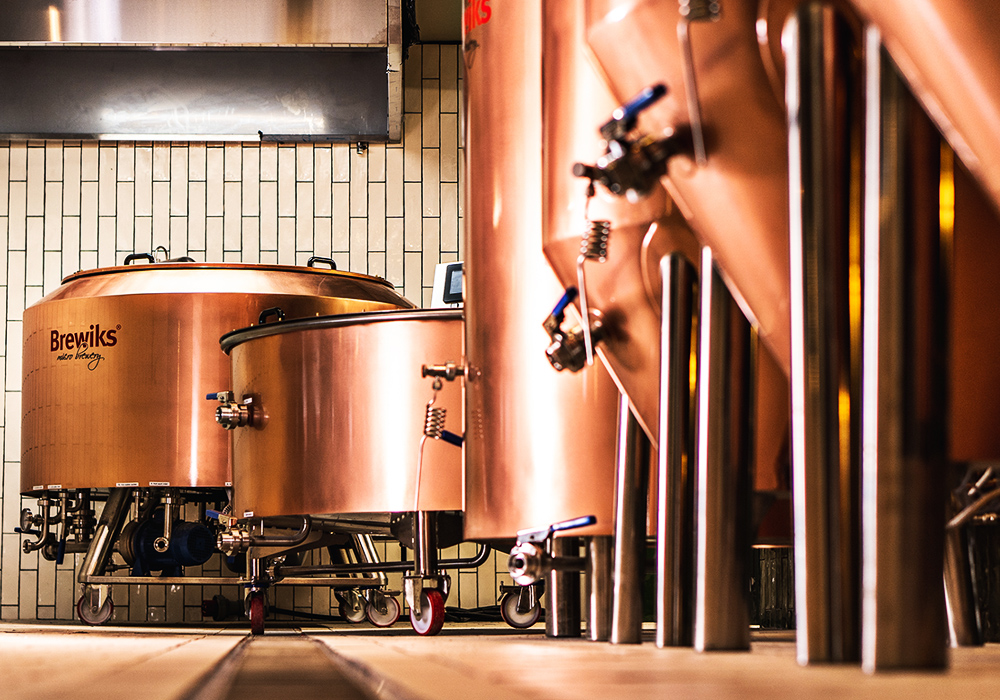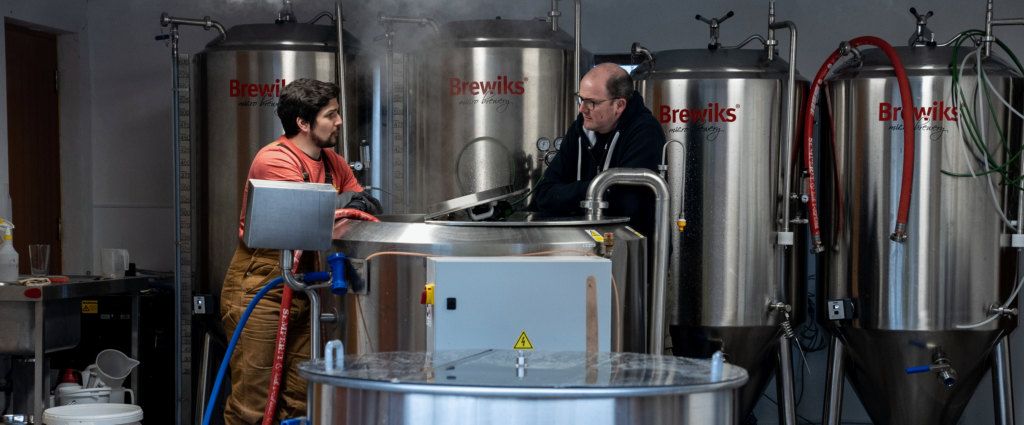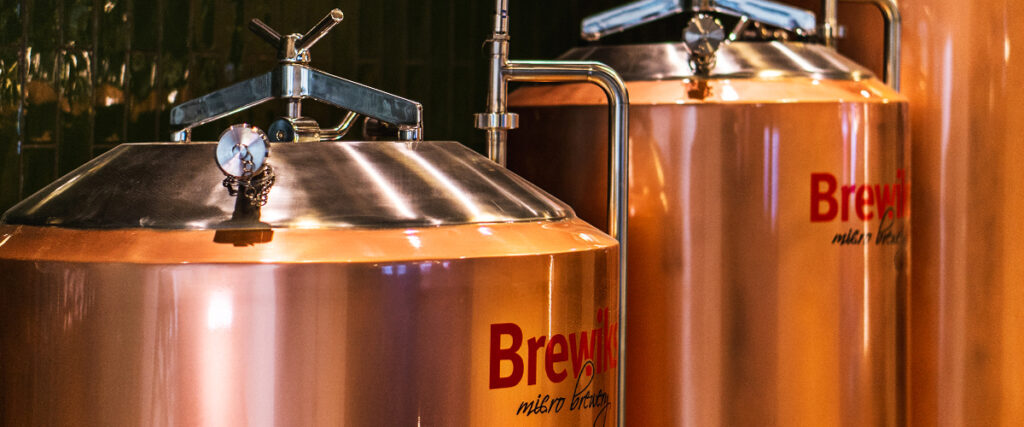Get Er Brewed recently posted a video to help our customers interested in starting their own brewery. The best place to start is with a Brewery Business Plan.

What do I need to start my own Microbrewery in the UK & Ireland?
- The Business Plan
- Deciding the size of your brewhouse
- Brand & Marketing
- Location
- Legalities & Licences
- Financing
- Consultation
- Beer
Get Er Brewed has been involved in the brewing industry since 2013, successfully launching over twenty breweries. Plus our brand supplies brewing ingredients to breweries as a core part of our business. We supply the brewing equipment brand Brewiks as an ultra-premium supplier aimed specifically at those who have no previous brewing experience. It’s a true plug and brew system and uses world-leading patented technologies.
How do I write a Brewery Business Plan?
A brewery business plan is a living document and a point of reference to help guide your business in the correct directions. The approach to writing the plan should give a structured framework for the journey and be suitable for review by investors or financial lending companies.
To start, your brewery business plan should look professional and be laid out in a structured and easy to navigate format. It is recommended that when populating each section with content, you should identify short, medium and long term goals. Always keep the quality of the beer at the forefront of your decision making, you want to be consistently brewing high-quality beer to help make your plan work effectively.
Section One
Table of Contents for your Brewery Business Plan
Executive Summary
- Include a summary of the whole plan here so best written at the end of the planning process
- Business aims – what are the goals for the brewery, is it to create a living for yourself and your family or are you building a brand to sell
- Financial summary – Again best completed at the end, this shows the viability of the project, identifying the returns and required funding to achieve this.
Section Two
Owners Background
- Why do you want to start a brewery?
- Previous work experience – Good to include a little about your experiences and what has brought you to this plan
- Qualifications & education – This is helpful for potential investors or funding options
- Training – This is to highlight if you have any training requirements for running a brewery, if you have any specific qualifications in brewing or if you have been an active homebrewer. You can include the use of brewing consultants assisting you.
- Hobbies & Interests – a little more about the people behind the project
- Additional relevant information

Section Three
Products and services
- What are you going to sell? Is it a brewery tour for a tourist attraction or is it solely production of packaged beer, look at packaging formats for eg keg & cask, bottles and cans and identify what direction you are going to take your packaging in. Perhaps you intend to offer white label brewing, so look at all possible revenue streams. You can sell the brewery experience in a brewpub set up which is effectively selling direct to the end user at the highest margin.
- Describe the beers & brewing experiences you are going to sell? Most breweries have a focused core range and release seasonal specials to compliment them. However we also some breweries that specialise in certain styles be that Lager, IPA’s or barrel aged beers
- Describe the different types of product/service you are going to be selling? Will you be aiming your beers to be sold as keg on trade or will you be offering out packaged beer to independent off sales. A consideration here could be if you intend to work with the “multiples” this covers large scale supermarkets for example. Are your products going to be distributed via a distribution partner or will you be doing distribution directly yourself?
- If you’re not going to sell your products at the start of the business, explain why not, when you will start and how the business will finance this period. This is particularly aimed at those brewing beer styles that take a considerable period of time to age. I’m not meaning a lager that takes 7 weeks, more at the long-term barrel aged beers or lambic that can take years to develop.
- Legal structure – Are you setting up as a limited company or will this be approached as sole trader; consideration should also be taken to becoming VAT registered
- Brewery Concept – There is a lot of different options and further to those hybrids that you may want to consider. We have worked with brewpubs selling direct, brewers brewing and completing their own distribution. Breweries that are making beer for distribution. Brewers that focus on supermarket sales and beer subscription services.
Section Four
The Market
- Identifying your customers and categorising them into sections e.g. Individuals, Distributors and businesses. The individuals will require market research to identify the demographics and then creating beer styles to target them. Distributors are important if you’re not going to self-distribute then will usually want something in the region of 15-25% percent depending on who you use.
- Describe your typical customer. Look at craft beer trends in your area and distribution of craft beer spend and not forgetting consumption rates.
- Where are your customers based – Local or international. Will you be focusing on your locality, or will you be looking to export?
- What prompts your customers to buy your beers?
- What is your USP (unique selling point)?
- How will you get the correct distribution and marketing?
- What do you offer that helps the customers choose your brewery?
- What is your back story and how will you communicate that to get consumers to buy your beer?
- Have you sold beer already?
- Have you got customers waiting to buy your product or service?
- Additional information
Section Five
Market Research
- Key findings from desk research – looking at the category, the customers and the market trends. In the UK there is over 3000 breweries as opposed to Ireland its currently in the region of 150, so it’s still a juvenile market in Ireland was scope for large scale expansion
- Key findings from field research – visit other breweries and see what the competition are doing this will help you with SWOT analysis also
- Key findings from test trading and identifying opportunities and potential challenges. Have you participated in recipe development and sought feedback from trusted sources? Pilot batches are a good way to start this
- Location for your brewery. Location is important for several reasons, will the premises be suitable for planning and approvals and will you have the correct utilities for example 3 phase electricity, good water supply etc. Premises are also important for costs and foot fall if your brewery model dictates that is required
- Additional information
Section Six
Marketing Strategy
- What you are going to do – there is so much that you can do in marketing now, but it needs to start with a back story and a brand identity. I would suggest this section is best layered out in a multi column table. I would suggest the following: Media Pack, Website with SEO focus & include a Blog. Social Media Channels ensuring you are protecting all your handles on the different platforms before launch. Videos to tell your story in a digital format. Merchandise for generating awareness and visibility for the brand. Mailing lists and planning for events to engage your followers on several different layers
- Why you have chosen this method – column 2 for explaining why you choose that particular type of marketing
- How much will it cost – costing in column 3 to calculate spend
- Additional information
Section Seven
Competitor Analysis
- Table of competitors
- SWOT Analysis
- Strengths and weaknesses of the competitors
- Opportunities
- Threats
- Unique selling Point
- Additional information
Section Eight
Operations and logistics
- Production – In my professional opinion production is best on a Brewiks Microbrewery brewing system
- Delivery to customers – If you are dealing direct, you will need your own transport, or you can assign professional and accredited hauliers
- Payment methods and terms – proforma or credit terms? If giving credit, how will you carryout due diligence checks and manage this
- Suppliers – Geterbrewed act as a true one stop shop for brewing equipment and ingredients
- Premises – Planning permission, layout in a suitable format to make production easy. Ensuring you have installed professional drainage and flooring and considered food safe requirements. If you consult your local EHO (environmental health officer) they can advise on what they would recommend. Preference is to have 3 phase electricity or a generator, you will also need to ensure you have a good water supply.
- Equipment – itemise all the equipment with a product description and costing
- Transport
- Legal Requirements –Planning for light industrial, brewers licence and wholesale licence, HACCP Plan and EHO approval.
- Insurance requirements
- Management & staff – costing for labour, the average salary for a brewer is approx. 22k for example
- Additional Information

Section Nine
Costs and pricing strategy
- Costing on recipes – Taking into account Grain, Hops, Yeast, Electricity, Labour, Packaging & duty. It’s important to get a cost per unit to identify the exact profit margin.
- Identifying the various Revenue Streams and providing projections
- Cost of buildings work
- Cost of brewery equipment
- Identifying running costs for energy – for example price per kwh
- Identifying running costs for labour – will you use contract packagers or invest in high-speed packaging equipment
- Why your business will be successful.
- You market research will identify what price independent craft beer is being sold at in your area e.g., £3.00 per 330ml can, 20% will be VAT, depending on the abv the duty to HMRC will be for e.g., 0.14p, the retailer will want 35%, the distributor will want at least 15% so you can work that back for forecasting. If we take an example that we brew 2000 litres of a 4.5% IPA using contract packagers for 330ml can with no volume discount; 0.47 canning & packaging, 0.14 duty, 0.12 ingredients, 0.05 labour, 0.03 power per unit = 0.81 per 330ml production cost. If we sell to distributor at 1.36 plus vat that gives us a 39.7% gross profit margin.
Recipe Example for an IPA
| 500L | 2000L | |||||
| Grain | Extra Pale | 100kg | £58.88 | £235.52 | ||
| Light Munich | 5.5kg | £3.43 | £13.72 | |||
| Hops | Styrian Goldings | 1Kg | £12.25 | £49.00 | ||
| Amarillo | 0.462kg | £12.47 | £49.88 | |||
| Cascade | 2.4kg | £39.00 | £156.00 | |||
| Yeast | Lallemand BRY97 | 500g | £53.44 | £213.76 | ||
| Total price | £717.88 | |||||
| Power (kw) | Time (hours) | Total (kwh) | ||||
| Electricity | HLT | 36 | 2 | 72 | ||
| Brewiks 500 | 36 | 2 | 72 | |||
| Brewiks + | 36 | 10 | 360 | |||
| Total (kwh) | 504 | |||||
| Price per kwh | £0.17 | Total price | £85.83 | |||
| Labour | Hourly wage | £14.42 | ||||
| Brew day | Hours | Total | ||||
| 20 | £288.40 | |||||
| Kegging day | 8.5 | £122.57 | ||||
| Canning | Price per 330ml can | £0.47 | Price per 440ml can | £0.47 | ||
| 330ml cans per 2000L | 6060 | 440ml cans per 2000L | 4545 | |||
| Toal canning price | £2848.20 | Total canning price | £2136.15 | |||
| Duty | Per 2000L | With SBR | Per 330ml can | Per 440ml can | Per 30L keg | Per 50L keg |
| £ | £1717.20 | £858.60 | £0.14 | £0.18 | £12.81 | £21.47 |
Section Ten
Financial Forecast
- A P&L report
- Assumptions on seasonal trends
- Sales forecast
- Costs forecast
- Budgeting
- Cashflow management
Section Eleven
Back Up Plan
- Short term, medium term and long term plans
- Contingency plans to help pivot and adapt in the event of difficult trading conditions. For instance the recent covid pandemic many breweries had to adapt from offering mainly draft beer to switching to almost complete packaged products, they had to get creative ways of getting around these difficult trading circumstances and it’s important to build these back up plans into you overall plan
Check out some of our YouTube videos